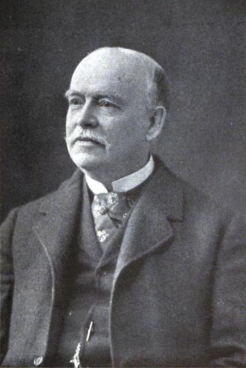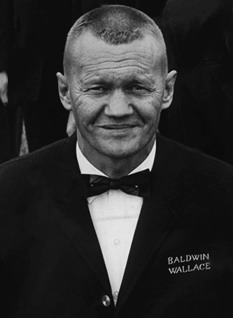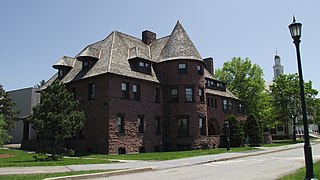
Berea is a city in Cuyahoga County, Ohio, United States. The population was 18,545 at the 2020 census. A western suburb of Cleveland, it is a part of the Cleveland metropolitan area. Berea is home to Baldwin Wallace University, as well as the training facility for the Cleveland Browns and the Cuyahoga County Fairgrounds.

Josiah Cleaveland Cady or J. Cleaveland Cady, was an American architect known for his designs in Romanesque and Rundbogenstil styles. He was also a founder of the American Institute of Architects.

Baldwin Wallace University (BW) is a private university in Berea, Ohio. Established in 1845 as Baldwin Institute by Methodist businessman John Baldwin, it merged with nearby German Wallace College in 1913 to become Baldwin-Wallace College.
Berea High School (BHS) was a high school located in Berea, Ohio, United States. It was founded in 1882 and served students in grades nine through 12. Its most recent campus, located immediately east of Baldwin Wallace University, was built in 1929. It was the first of two public high schools in the Berea City School District, along with Midpark High School, which opened in 1962. Both BHS and Midpark were closed in 2013 at the conclusion of the 2012–13 school year and were consolidated at the BHS campus to form Berea–Midpark High School. Berea's school colors were scarlet and royal blue, and its athletic teams were known as the Braves. The school's fight song was Ohio State University's "Across the Field".
Neal Malicky served as the sixth president of Baldwin-Wallace College in Berea, Ohio from 1981 to 1999. Malicky was succeeded by Mark H. Collier in 1999. A building on the north side of BW's campus bears Malicky's name. The Neal Malicky Center for the Social Sciences was named in his honor in 2001.
Mark H. Collier was an American religious scholar and academic administrator who served as the seventh president of Baldwin-Wallace College in Berea, Ohio, from 1999 to 2006.
Arthur Louis Breslich was a professor, university administrator, and a German Methodist theologian. He was President of German Wallace College, Berea, Ohio; and the first president of Baldwin-Wallace College in Berea.

Lee Tressel was a football coach and athletic director at Baldwin–Wallace College in Berea, Ohio. Tressel accumulated the most winning record as the head football coach at Baldwin–Wallace. His 1978 team won the NCAA Division III Football Championship, achieved National Coach of that year, and in 1996 was inducted into the College Football Hall of Fame.

John Baldwin was an American educator, and the founder of Baldwin Institute in Berea, Ohio, which would eventually merge into Baldwin–Wallace College, now Baldwin-Wallace University. He was also the founder of Baker University and Baldwin City, Kansas, and contributed money to start schools in Bangalore, India that are today called Baldwin Boys High School, Baldwin Girls High School and Baldwin Co-Education Extension High School.
The Historic District of the Georgia Institute of Technology, also known as the Old Campus of Georgia Tech or the Hill District, is significant in the areas of architecture, education, engineering and science, as well as landscape architecture. The area is a Registered Historic Place and part of the central campus of Georgia Tech. Located in Midtown Atlanta, Georgia, United States, it is roughly bounded by North Avenue on the South, Bobby Dodd Stadium, a 55,000 seat football stadium on the East, Bobby Dodd Way on the North and Cherry Street on the West.
This is an incomplete list of historic properties and districts at United States colleges and universities that are listed on the National Register of Historic Places (NRHP). This includes National Historic Landmarks (NHLs) and other National Register of Historic Places listings. It includes listings at current and former educational institutions.

Lincoln Hall is the administrative center of Berea College in Berea, Kentucky. Built in 1887 and named in honor of Abraham Lincoln, it was declared to be a U.S. National Historic Landmark in 1974 in recognition of the college's role as the first school of higher education in the nation established to provide a racially integrated educational environment.
The Campus of the University of Southern California, also known as the University Park Campus is located in the Exposition Park neighborhood of Los Angeles, California. The campus sprawls across 226 acres and contains most of the academic facilities and residential buildings of the University of Southern California. The University Park campus is in the University Park district of Los Angeles, 2 miles (3.2 km) southwest of downtown Los Angeles. The campus's boundaries are Jefferson Boulevard on the north and northeast, Figueroa Street on the southeast, Exposition Boulevard on the south, and Vermont Avenue on the west. Since the 1960s, through-campus vehicle traffic has been either severely restricted or entirely prohibited on some thoroughfares. The University Park campus is within walking distance to Los Angeles landmarks such as the Shrine Auditorium and Los Angeles Memorial Coliseum, which is operated and managed by the University. Most buildings are in the Romanesque Revival style, although some dormitories, engineering buildings, and physical sciences labs are of various Modernist styles that sharply contrast with the predominantly red-brick campus. Widney Alumni House, built-in 1880, is the oldest university building in Southern California. In recent years the campus has been renovated to remove the vestiges of old roads and replace them with traditional university quads and gardens. The historic portion of the main campus was listed on the National Register of Historic Places in 2015.

Stephen Carpenter Earle was an architect who designed a number of buildings in Massachusetts and Connecticut that were built in the late 19th century, with many in Worcester, Massachusetts. He trained in the office of Calvert Vaux in New York City. He worked for a time in partnership with James E. Fuller, under the firm "Earle & Fuller". In 1891, he formed a partnership with Vermont architect Clellan W. Fisher under the name "Earle & Fisher".

The history of Baldwin Wallace University dates back to 1828, when co-founder John Baldwin settled in present-day Berea, Ohio. His founding eventually established Baldwin–Wallace College. This founding of present-day Baldwin Wallace University began when Baldwin Institute was established in 1845. With the help of James Wallace, Baldwin Institute began offering college courses. Eventually, in 1863, a resolution established a separate school from Baldwin University to serve the booming local German population called German Wallace College. Originally part of Baldwin Institute, German Wallace College was established just down the road. As a result of financial hardships the schools merged in 1913, forming Baldwin-Wallace College. In 2010, several buildings were added to the National Register of Historic Places combining the former Lyceum Village Square and German Wallace College to form the BW South Campus Historic District. In 2012, Baldwin-Wallace College became Baldwin Wallace University and established the BW North Campus Historic District. The Conservatory is home to the Baldwin-Wallace Bach Festival, the oldest collegiate Bach Festival and the second-oldest Bach festival in the United States honoring Johann Sebastian Bach.

John Wheeler (1815–1881) was an American educator, the second principal of Baldwin Institute, and the first president of Baldwin University in Berea, Ohio. Baldwin College would eventually merge with nearby German Wallace College to become Baldwin–Wallace College. Wheeler has a building named after him on the Baldwin Wallace University campus.

Baldwin-Wallace College North Campus Historic District is an area of land on the north end of the Baldwin Wallace University campus. BW is a four-year private, coeducation, liberal arts college in Berea, Ohio, United States. The school was founded in 1845 as Baldwin Institute by Methodists settlers. Eventually the school merged with nearby German Wallace College in 1913 to become Baldwin-Wallace College, which changed its name to "Baldwin Wallace University" in 2012. Several buildings since its founding have been established on the National Register of Historic Places, establishing this area as the Baldwin-Wallace College North Campus Historic District. This area is the second historic district added to the campus which includes the BW's South Campus Historic district

Redstone is a historic former estate on South Prospect Street in Burlington, Vermont. It was developed in 1889, and includes some of Burlington's finest examples of Richardsonian Romanesque, Shingle, and Colonial Revival architecture. Its surviving elements are Redstone Green and some of its surrounding buildings on the campus of the University of Vermont, which acquired the property in 1921, and are part of the university's Redstone Campus. It was listed on the National Register of Historic Places in 1991 as the Redstone Historic District.

The John Wheeler House, also known as The Little Hermitage of Berea, was home to John Wheeler, an American educator and the first president of Baldwin University in Berea, Ohio. Baldwin College eventually merged with nearby German Wallace College to become Baldwin Wallace University. Wheeler also has a building named after him on the Baldwin Wallace University campus. Wheeler's home, built in 1834, is the oldest continuously occupied residence in Berea, Ohio.






















